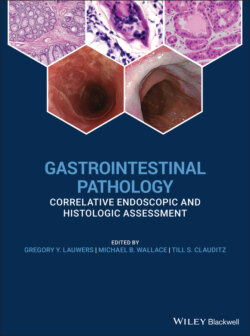Читать книгу Gastrointestinal Pathology - Группа авторов - Страница 67
Microscopic
ОглавлениеThe histologic appearance of EOE is not specific, and mucosal infiltration by eosinophils is a component of a variety of other esophageal inflammatory conditions (Table 2.4).
GERD and PPI‐responsive esophageal eosinophilia exhibit considerable histologic overlap with EOE. In an untreated patient, fewer numbers of eosinophils with distal predominance may be suggestive of GERD. Correlation with response to PPI therapy is paramount.
In eosinophilic gastroenteritis, obtaining biopsy specimens from the stomach and duodenum and other clinical symptoms such as nausea, vomiting, and diarrhea may be helpful in establishing a diagnosis.
The presence of granulomas is helpful in diagnosing esophageal involvement by Crohn’s disease, but they are uncommon. Eosinophils may also be admixed with neutrophils and lymphocytes, and involvement of other parts of the GI tract is typically present.
Infections are recognized by the identification of viral inclusions (such as HSV), and fungal or parasitic organisms. Mixed inflammation with neutrophils may also be present. Rare cases of HSV esophagitis occurring in a background of EOE have been described.
Table 2.4 Endoscopic and histologic features of the major causes of infectious esophagitis.
| Organism | Endoscopic features | Morphological features | Ancillary studies |
|---|---|---|---|
| Candida | Focal or confluent white plaques | Parakeratosis with neutrophils Colonization of ulcers Budding yeast, pseudohyphae, occasional septate hyphae Superficial invasion typical | PAS‐diastase, GMS stains |
| Herpes simplex | Superficial ulcers, multiple | Edge of ulcer—inclusions in squamous cells and/or squamous debris of ulcer slough Multinucleation, ground glass nuclei, dense eosinophilic nuclear inclusions (Cowdry type A) | IHC |
| CMV | Single deep ulcer, linear ulcers | Base of ulcer—inclusions in endothelial and stromal cells Intranuclear (“owl's eye”) and granular cytoplasmic inclusions Atypical inclusions common | IHC |
Table 2.5 Conditions associated with esophageal eosinophilia in the differential diagnosis of EOE.
| GERD |
| PPI‐responsive esophageal eosinophilia |
| Eosinophilic gastrointestinal diseases |
| Crohn's disease |
| Infection (Candida, HSV, parasites) |
| Hypereosinophilic syndrome |
| Achalasia |
| Drug hypersensitivity injury |
| Vasculitis |
| Pemphigus |
| Connective tissue diseases |
| Graft versus host disease (GVHD) |
In drug‐induced esophageal eosinophilia, there is a temporal relationship and resolution when the offending agent is withdrawn.
